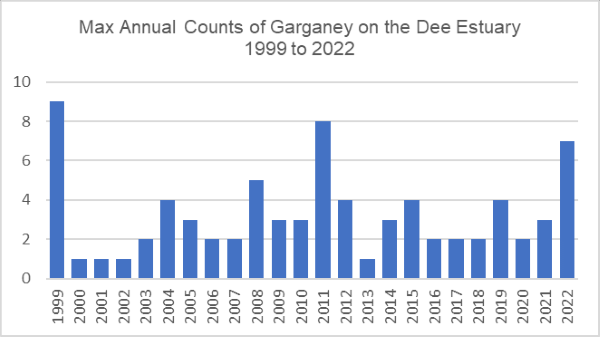Dee Estuary Birding
Monthly Newsletter...
June 2022 Newsletter
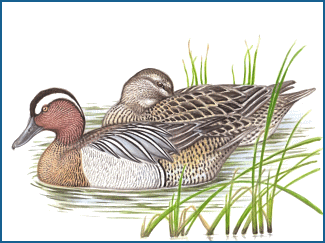
Species Spotlight - Garganey
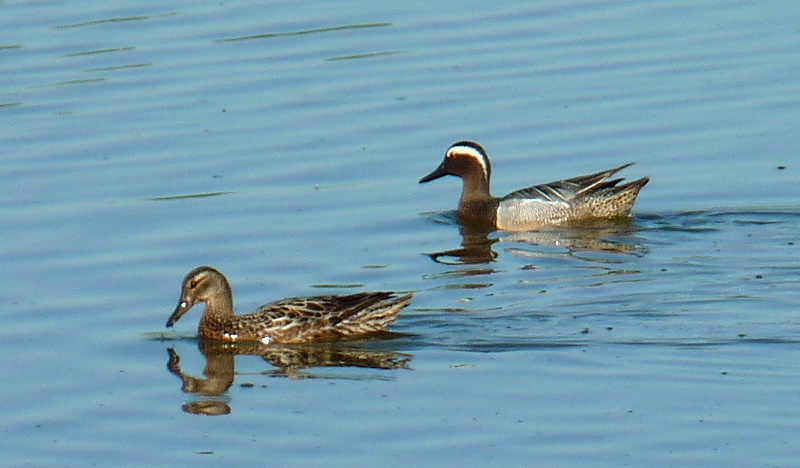
Late March this year saw a remarkable influx of Garganey into the UK.
Exceptional numbers were seen in the south of England including a flock
of 32 past Dungeness on the 21st and 26 offshore at Thurlestone, Devon,
on the 19th with smaller flocks widespread across England and Wales,
including here on the Dee Estuary. The influx appears to have been
caused by a south-easterly airflow with very mild conditions
encouraging the birds to move further north and west than normal during
migration.
The first two arrived at Burton Mere Wetlands (BMW) on the early date of March 20th, there have only been five earlier records this century on the Dee Estuary. Numbers then quickly built up and by the 23rd we had seven. This relatively high number then remained for the rest of the month until reverting back to the more usual ones and twos by early April. A look at the half-monthly distribution chart below shows there were more than five times the number of daily records in the last two weeks of March 2022 than the total for those same two weeks for the previous 22 years!
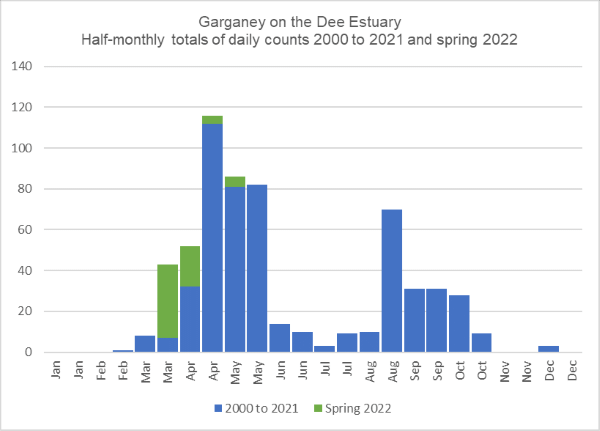
Since the year 2000 the earliest bird to arrive was on February 16th (in 2012). Most first arrivals come in March but, as you can see from the half-monthly distribution above, the spring migration doesn't really get under way until the second half of April. For the return migration, which nearly always involves less birds than in spring, the second half of August is when we see most movement, tailing off into September and October. Winter records are virtually unknown in this country so it is surprising that we have had two birds in December - one at BMW in 2000 and one at Point of Ayr in 2006.
The max count of seven in March 2022 wasn't a record count for the Dee Estuary, that was at Inner Marsh Farm RSPB with nine on August 13th 1999, and the second highest (eight) was at the same site in April 2011. It is only comparatively recently that the Garganey has become a regular visitor to the Dee Estuary. In the 19th century it was a real mega rarity with Coward mentioning only three records, all on Burton Marsh (and that was for the whole of Cheshire). Even in the 20th century they were far from annual until the 1990s. A look at the Cheshire Bird Reports from 1964 reveals not a single bird was reported from the Cheshire side of the estuary until 1989 (although they were regular elsewhere in Cheshire by that time). It was the creation of the fresh water reserve Inner Marsh Farm by the RSPB in 1989 (later to be enlarged in 2011 and become BMW) which has made a huge difference to the fortunes of this species and since the 1990s they have became regular here during both the spring and autumn migrations. They are still quite scarce, though, and over 90% of records this century are of just one or two birds.
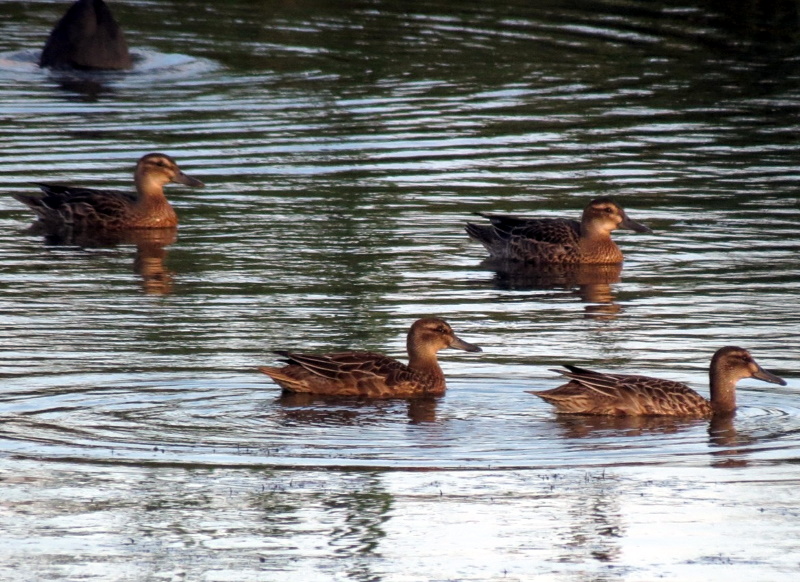
The pie-chart shows the sites Garganeys have
been found between 2000
and 2022 around the estuary with the majority, being seen at Burton
Mere Wetlands/Inner Marsh Farm. The site with the second highest
number of records is Point of Ayr and Talacre, but that is slightly
misleading as most records involved just the single bird which stayed
in the area for over a month in the autumn of 2012.

Garganeys aren't easy to monitor as they often hide
away in reeds and can disappear for days before re-appearing, and
then you are never quite sure if they are the original ones or 'new'
in. Trying to establish the presence or not of these ducks is a
particular problem during the breeding season when they are even more
secretive. Breeding around the estuary has never been confirmed
although they have bred elsewhere in Cheshire, the latest successful
pair being at Woolston Eyes in June 2019 when they were seen with a
brood of four young ducklings. However, there have been many cases of
suspected breeding including at Shotton Lagoons way back in 1960 when a
pair had been spotted a few times in the reeds in May and June before
six immature birds were recorded in July - but they were by then fully
grown so it wasn't possible to say for sure that they had hatched on
the reserve. More recently, at BMW, several times there have been one
or two Garganeys present through the summer and they have been reported
as either 'possible breeding' or 'probable breeding' to the Rare
Breeding Birds Panel, but young ducklings have never been seen here.
Since that very busy period in March and early April
it's been very quiet this spring for Garganeys with just two seen in
May, one of which turned up at BMW on the very last day of the month.
May be this will be one that stays for the summer!

References
1. Birdwatch magazine, May 2022.2. Cheshire Bird Reports/Cheshire & Wirral Bird Reports from 1964 to 2020 (CAWOS)
3. North-east Wales Bird Reports (various between 2000 and 2019), Clwyd Bird Reporting Group.
4. Birdguides reported sightings of Garganey 2000 to 2022.
5. Garganey sightings in www.deeestuary.co.uk.
6. T.A. Coward, The Fauna of Cheshire, Witherby, 1910.
7. Rhion Pritchard et.al, The Birds of Wales, Liverpool University Press, 2021.
8. David Norman, Birds in Cheshire and Wirral (Breeding and wintering atlas), 2008 (CAWOS).
Richard Smith
Colour Ring Report
An interesting selection of colour-ringed birds this month and a special thanks to the very active Mid-Wales Ringing Group who ring many of the birds we see here, including three of the ones described below.
Cormorant
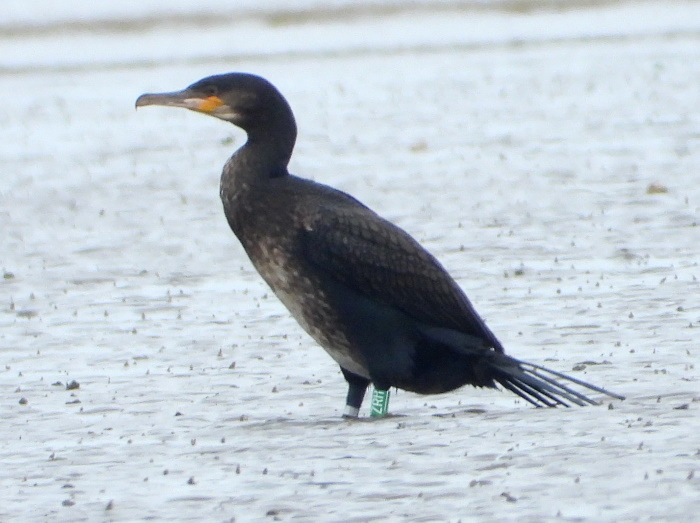
Green Ring ZRH.
Ringed on Puffin Island, Anglesey, on 02/07/2021 as a chick.
Recorded:
East Hoyle Bank just east of Hilbre on 14/08/2021
Bird Rock (Red Rocks) on 15/05/2022.
When recorded near Hilbre last August it was the first sighting of that
year's chicks away from Puffin Island.
Dunlin

White flag C12
Ringed near Gdansk on 15/08/2021
Recorded at Hilbre on 05/09/2021
We've only just got feedback for this Dunlin. Sometimes we do have to
wait months for feedback - perhaps the ringer lost his notes!
Over the decades the Polish Bird Ringing Centre have ringed many
thousands of Dunlin in the mouth of the Vistula River near Gdansk.
We've seen quite a few here in the past and they have all had white
rings. I guess, therefore, they have now run out of combinations to put
on
the rings so have now started using white flags - and this is the first
flagged one we've seen.
Turnstones
Two flagged turnstones in three days was a nice
surprise in mid-May.

Red Flag (LAC) - Y
Ringed at Ynyslas, Cardigan Bay, on 06/09/2022.
Recorded:
Gavres, Brittany, France on 2/03/2022 and 04/03/2022.
Hilbre on 14/05/2022.
This bird has only been recorded on migration. Quite a lot of
Turnstones do winter around Brittany and the Atlantic coast of France,
or it could have travelled travel all the way from Mauritania like the
next bird.

Orange Flag (CKN) - R
Ringed on the island of Schiermonnikoog in the Waddensea, Netherlands,
on 26/07/2017
Recorded:
Ban d'Arguin, Mauritania on 14/01/2018, 9/12/2018 and 10/12/2018.
Hilbre on 12/05/2022.
This bird's presence in the Waddensea in July and
the fact that it overwinters in Mauritania suggests this is one that
breeds in Scandinavia (or further east) rather than Greenland or
north-east Canada. There can't be many, if any, colour-ringed
Turnstones which have been recorded both in Mauritania and on the Dee
estuary.
Black-tailed Godwit
LO-RH (lime green
over orange - red over yellow enscribed with a black H)
Ringed on the Tagus Estuary, Setubal, Portugal, on 07/01/2019.
Recorded on four dates in February 2019 and twice in February 2021 on
the Tagus Estuary.
Seen at Burton Mere Wetlands on 04/04/2019 and 13/04/2022.
Oystercatcher
O-G(MH) (orange
ring - green ring enscribed with MH)
Ringed on the River Severn by Forden, Montgomeryshire.
Recorded at Thurstaston on 09/04/2022.
Whimbrel

G-Y(E61)
Ringed at Llanon on Cardigan Bay on 02/05/2018
Recorded at Thurstaston on 08/05/2022
Lesser Black-backed Gull

N:4FC on a white
ring.
Ringed in Puerto de la Caleta de Velez (just east of Malaga), Spain, on
14/02/2020 as a second calendar year bird.
This bird spent October to April at the ringing location (with a few
sightings also in Malaga) during the winters of 2020/21 and 2021/22.
Last seen there 11/04/2022.
Recorded at Heswall on 14/05/2022.
No other records so we don't know if it spent two summers elsewhere on
the Costa del Sol or, perhaps, returned to the UK. It's presence at
Heswall in May this year suggests it may be returning to breed in the
UK where it presumably originally hatched.
Colour Rings were recorded by Richard Smith, Steve
Hinde, Andrea Sawiak, Richard Speechley, Matt Thomas, Ed Wilson and
Lesley Dolbear.
Richard Smith
May Bird News

Spring migration was still in full swing during the
first half of May. Migrants included four Wood Sandpipers at Burton
Mere Wetlands on the 3rd, three Arctic Terns off Meols on the 4th and a
total of three Curlew Sandpipers between the 15th and 17th. But
the most notable record was of 211 Whimbrel counted at Heswall Shore on
the 5th, that's three years in a row we've had a record high count for
the estuary (173 in 2021). Several hundred Dunlin were on Hoylake Shore
on the 16th and included the sub-species arctica, the smallest of the Dunlin
which breed in Greenland, but there were also several large Dunlin
which looked very like the centralis
race (see photo below) which have never been confirmed as a
British visitor (i.e. not on the British list) even though we see them
at Hoylake every May! These big Dunlin breed across northern Siberia.
See Dunlin
- Rings, Races and Genes for more info on the mysteries of Dunlin
races.
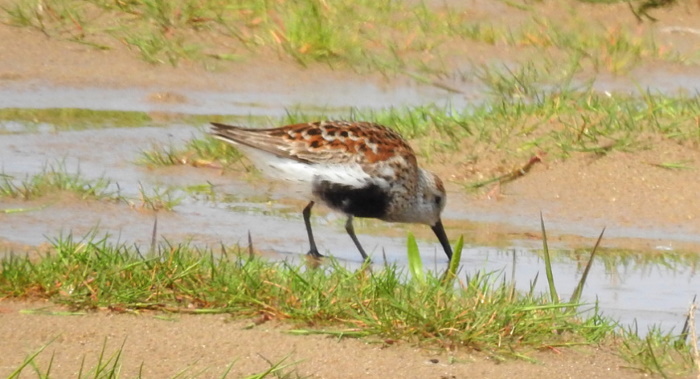
The 16th saw the peak of the Spotted Flycatcher migration with over five at Leasowe and at least three at Hoylake. Also at Hoylake on the same day was a Black Tern. There were 11 Cuckoo records through the month, a good total for this declining species.
Six Ospreys, seven Hobbies and seven Red Kites were
spotted through the month, and there was an unusually late sighting of
a Short-eared Owl at Gronant on the 26th. But undoubtedly the most
unexpected record was a Puffin off Connah's Quay Nature Reserve on the
15th. This is almost as far into the estuary as you can get, very
unusual for a species which is normally only ever seen, and then only
two or three times a year, out in Liverpool Bay.

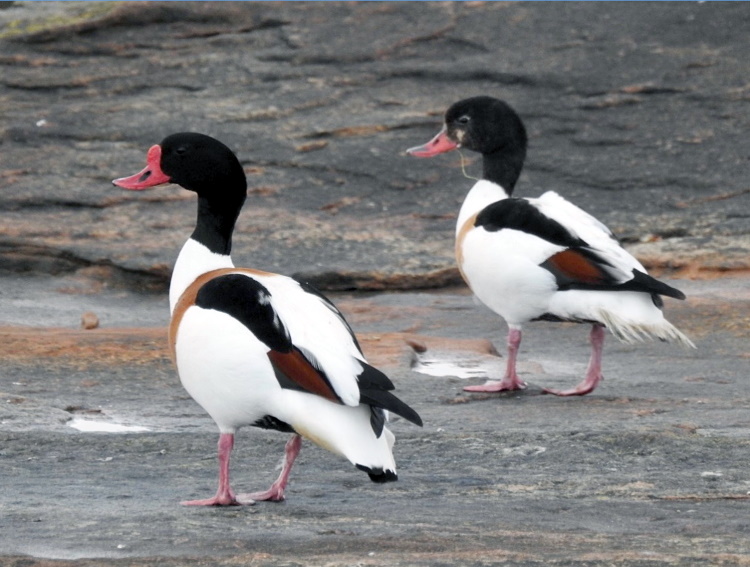
What to expect in June
It may be approaching mid-summer but for the birds
the beginning of June is still spring with a few waders migrating
through on their way north, whilst by the month-end it can seem like
autumn with some arriving back on the estuary after breeding. Look for
Sanderling and Ringed Plover on the first few days of the month as they
will have come from a long way south, perhaps as far as South Africa
and will be on their way to the far north. As early as mid-June it's
possible that we will have the first Spotted Redshanks back, probably
at Burton Mere Wetlands, and both Common and Green Sandpipers could
arrive back over the following two weeks.
We do have over-summering birds on the estuary
including those that breed here such as Avocet, Redshank and Lapwing,
and last year there were record numbers of pairs at Burton Mere
Wetlands. We also see non-breeding birds including Black-tailed Godwits
and sometimes good numbers of Knots. But the first of the breeding
Black-tailed Godwits should start flying back in the last few days of
June looking wonderful in their full breeding plumage.
Other breeding birds on the estuary are terns and a
visit to the Little Tern colony at Gronant, one of the biggest in the
country, is an amazing experience at this time of year.
Given a strong westerly sea-watching can be good with Manx Shearwaters and perhaps Storm Petrels in view, but we really don't want gales in June as it will play havoc with those Little Tern nests at Gronant!
June can bring a really good rarity or two, and last year we had a Red-back Shrike at Leasowe and a probable Caspian Tern distantly seen heading west past Hoylake.

Forthcoming Events
June Highest Spring Tides (Liverpool)
Also see Tides page.
15th June, 12.24hrs (BST), 9.4m.
16th June, 13.15hrs (BST), 9.4m.
